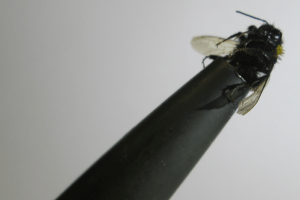Feb 19 2018
Pitots provide airspeed data and these have played a role in numerous aircraft accidents, including the fatal Air France Flight 447 in 2009. Recent research by aerospace engineers at the University of Bristol has discovered that an acoustic blockage-detection system could prevent accidents in the future by alerting pilots about a blocked Pitot before a situation becomes serious.
 A bee on a Pitot tube. (Image credit: University of Bristol)
A bee on a Pitot tube. (Image credit: University of Bristol)
Acoustic techniques have been used for sensing blockages in pipes and even the ears of newborn babies for numerous years. The research, published in Journal of Aircraft, aimed to discover if similar approaches could be used for real aircraft Pitot tubes, which can contain irregular passages and shapes, without needing a very complicated detection technique.
The method has been suggested before, but no extensive data, either simulated or experimental, has been published thus far. The researchers were keen to find out if it would be possible to detect typical blockage types that aircraft face, including ice, tape, and insects.
Three Pitot-statics from two different commercial aircraft were X-rayed by a CT scanner and an acoustic investigation was conducted to note the variation between blocked and unblocked reflected acoustic waves. Experiments using a variety of blockage types, including tape, foam, insects, and metal, were also done on the same tubes.
The research found it is possible to detect blockages consistently, even for principally small tubes, and for tubes having non-cylindrical shapes. However, for the technique to work properly, it is necessary for there to be a simple tube along a majority of the length of the pressure duct.
In principle, the method could be adopted to help inform pilots if Pitots are blocked before they take off, or if they subsequently become blocked during a flight.
Our results are encouraging for a ground operable system, but the effect of the background noise field in flight needs to be established before a flight operable system could be implemented.
Dr. Thomas Rendall, Co-Author & Senior Lecturer - Department of Aerospace Engineering at the University of Bristol
The data from the research is applicable only for a Pitot in an aircraft on the ground. The following phase of the research would be for the system to be examined for in-flight operation, which would require comprehensive noise data from a real aircraft. The system would also have to be made smaller to fit into the tight limits of an aircraft structure. The team recommends that now would be a good time for the industry to begin testing a flight operable system, as they have access to equipment and data.